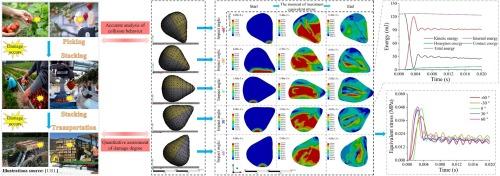基于动态有限元法和响应面法耦合的草莓鲜果采后早期隐性损伤的测定和定量评估
IF 7.7
1区 农林科学
Q1 AGRICULTURE, MULTIDISCIPLINARY
引用次数: 0
摘要
碰撞损伤是草莓机械化收获、堆垛和运输过程中最常见的损伤类型。针对碰撞行为造成的果实隐性碰伤在损伤早期难以检测和准确量化的问题,本文基于动态有限元法和响应面法对草莓果实碰撞瞬间的碰伤敏感性进行了模拟和实验研究。通过测量三个不同品种草莓果实的物理特性参数,建立了包括皮层、中心髓和瘦果在内的果实三维实体模型。根据准静态压缩实验获得的力学特性参数,进一步建立了果实的多尺度有限元模型。本文共设置了 240 个不同的实验场景,得到了不同条件下果实等效应力的云图和系统能量的变化规律。实验结果表明,由于接触材料、下落高度和冲击角度的不同,水果内部的等效应力和接触力也不同。为了进一步获得接触材料、下落高度和撞击角度对碰伤易感性的综合影响,利用响应面方法建立了四个预测碰伤易感性的经验模型。通过比较实验结果和模型预测结果,发现在接触材料为钢、下落高度为 1 m 的条件下,当冲击角为 -19° 时,测量值与预测值的相对误差最小(1.38 %);当冲击角为 -31° 时,测量值与预测值的相对误差最大(6.43 %)。研究结果表明,基于响应面方法的草莓果实青果敏感性预测模型是合理和正确的。这些模型可用于确定草莓果实在机械化采摘、堆垛和运输过程中可能受到的机械损伤,并可为草莓或其他果蔬采摘机器人的末端执行器/机械手的开发、采摘/收获策略的制定以及包装容器结构的设计提供依据。本文章由计算机程序翻译,如有差异,请以英文原文为准。

Determination and quantitative evaluation of early postharvest hidden damage in fresh strawberry fruit based on coupling of dynamic finite element method and response surface methodology
Collision damage is the most common type of damage during the mechanized harvesting, stacking and transportation of strawberries. Aiming at the problem that hidden bruises on fruits caused by collision behaviors are difficult to detect and accurately quantify in the early stage of damage, this paper carried out simulation and experimental research on the bruise susceptibility of strawberry fruits at the moment of collision based on dynamic finite element method and response surface method. By measuring the physical characteristics parameters of three different varieties of strawberry fruits, the three-dimensional solid model of the fruit including cortex, central pith, and achene was established. The multi-scale finite element model of the fruit was further established based on the mechanical property parameters obtained based on the quasi-static compression experiment. A total of 240 different experimental scenarios were set up in this paper, and the cloud diagrams of fruit’s equivalent stress and the changing law of system energy under different conditions were obtained. The experimental results showed that the equivalent stress and contact force inside the fruit vary due to differences in contact material, drop height and impact angle. In order to further obtain the comprehensive effects of contact material, drop height and impact angle on bruise susceptibility, four empirical models for predicting bruise susceptibility were established by using response surface methodology. By comparing the experimental results with the predicted results of the model, it was found that under the conditions where the contact material was steel and the drop height was 1 m, the relative error between the measured value and the predicted value was the smallest (1.38 %) when the impact angle was −19°; the relative error between the measured value and the predicted value was the largest (6.43 %) when the impact angle was −31°. The results of this study showed that the predicting models of strawberry fruit’s bruise susceptibility based on response surface methodology were reasonable and correct. These models can be used to determine the potential mechanical damage of strawberry fruits during mechanized harvesting, stacking and transportation, and can provide a basis for the development of end-effectors/manipulators in strawberry or other fruit and vegetable picking robots, the formulation of picking/harvesting strategies, and the design of packaging container structures.
求助全文
通过发布文献求助,成功后即可免费获取论文全文。
去求助
来源期刊

Computers and Electronics in Agriculture
工程技术-计算机:跨学科应用
CiteScore
15.30
自引率
14.50%
发文量
800
审稿时长
62 days
期刊介绍:
Computers and Electronics in Agriculture provides international coverage of advancements in computer hardware, software, electronic instrumentation, and control systems applied to agricultural challenges. Encompassing agronomy, horticulture, forestry, aquaculture, and animal farming, the journal publishes original papers, reviews, and applications notes. It explores the use of computers and electronics in plant or animal agricultural production, covering topics like agricultural soils, water, pests, controlled environments, and waste. The scope extends to on-farm post-harvest operations and relevant technologies, including artificial intelligence, sensors, machine vision, robotics, networking, and simulation modeling. Its companion journal, Smart Agricultural Technology, continues the focus on smart applications in production agriculture.
 求助内容:
求助内容: 应助结果提醒方式:
应助结果提醒方式:


